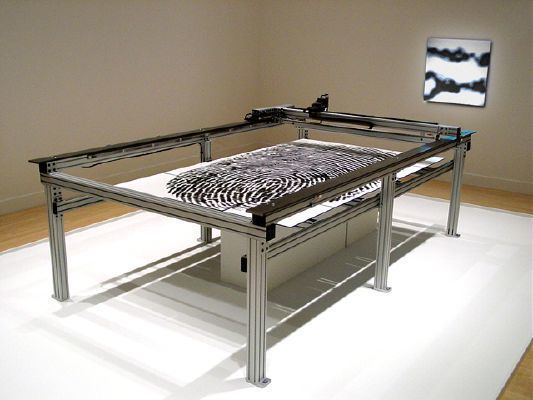Nationality American Name Shawn Brixey | Role Artist | |
 | ||
Full Name Shawn Alan Brixey Movement Art, Science and Technology, Phenomenological Art Known for Digital art, Telematics, Physics, BioArt | ||
Shawn brixey presentation for yes and yes and more and yes a toast to robin held
Shawn Alan Brixey (born 1961 Springfield, Missouri) is an artist, educator, researcher, writer, and inventor working primarily at the interface of art, science and technology.
Contents
- Shawn brixey presentation for yes and yes and more and yes a toast to robin held
- Creativity and art of the disciplined imagination shawn brixey tedxvaughan
- Academic career
- Experimental media art
- Exhibitions
- Awards and distinctions
- References

Brixey is the Dean of the Faculty of Fine Arts at York University, in Toronto, Canada. Brixey was a co-founder and former director of the DXARTS Center for Digital Arts and Experimental Media at the University of Washington, Seattle.

Creativity and art of the disciplined imagination shawn brixey tedxvaughan
Academic career
Brixey was born in Springfield, Missouri. Brixey received a BFA in Sculpture and Experimental Media from the Kansas City Art Institute in 1985.
Brixey received an MSVisS in Media Arts and Sciences from the Massachusetts Institute of Technology in 1988. At MIT he studied at the Media Laboratory and the Center for Advanced Visual Studies.
In 1989 Brixey was selected as the inaugural Leonardo Fellow at the University of Michigan, Ann Arbor, and as a Visiting Artist at the Cranbrook Academy of Art in Bloomfield Hills Michigan. In 1990 he joined the faculty of the University of Kentucky and founded their New Media Program which grew to include artist Eduardo Kac. In 1994 he joined the faculty at the University of Washington, and Chaired the new Interdisciplinary Visual Arts Program until 1997. In 1997 He received San Francisco State University's first Presidential Distinguished Scholar Award and helped found their New Media Institute. In 1998 he joined the faculty at the University of California, Berkeley, and was the Founding Director of the New Media Program. He rejoined the faculty at the University of Washington in 2002 to Co-Found the new DXARTS program along with composer Richard Karpen. In 2009 Brixey was honored with the University of Washington's Floyd and Delores Jones Endowed Chair in Arts and Sciences. Brixey has served as Creative Director for the Center for New Cinema since 2009.
Brixey was Co-Founder and former Director of the University of Washington's Center for Digital Arts and Experimental Media. Established in 2002, DXARTS offers both hybrid B.F.A. and Ph.D. degrees.
In 2009 Brixey served as the chair of the New and Virtual Media Directorate for the Canadian Foundation for Innovation. He currently serves on the board of Seattle-based non-profit, The Center for New Cinema (CNC). Brixey was appointed in 2011 to the International Scientific Advisory Council for GRAND, a National Research Council Canada networked research program.
In 2013 Brixey became Dean of the Faculty of Fine Arts at York University.
In 2017 Virginia Commonwealth University announced that the Toronto educator Shawn Brixey was named new dean of the VCU School of the Arts, following the tenure of former dean Joseph H. Seipel.
Experimental media art
Brixey is best known for pioneering highly complex experimental artworks that synthesize physics, astronomy, cosmology, biology and advanced computing. An example is his 1987 project Photon Voice, which uses (the kinetic momentum of photons) in sunlight to build a micro-gravitational system. The light source developed for the project encoded an intense beam of sunlight with the artist's voice and was the used to levitate tiny galaxies of graphite particles in a vacuum chamber.
In Brixey's project Alchymeia, designed for the 1998 Winter Olympics in Nagano, Japan, the naturally occurring steroids from the blood and urine of Olympic athletes were used as doping agents to stimulate the growth of unusual snowflakes that would otherwise be impossible to find in nature.
Chimera Obscura, created in collaboration with UC Berkeley Museum curator Richard Rinehart was commissioned for the 2002 premiere of the touring exhibition Genesis | Contemporary Art Explores Human Genomics at the University of Washington’s Henry Art Gallery. Chimera Obscura examined issues of genomic research through the creation of a massive multi-user data driven organism. The project centered on the operation of a precision tele-robot that online visitors piloted through an elaborate real-world maze in a museum created from a human thumbprint. As visitors moved through the maze space they left behind archeological layers of virtual information genes in the form of text, video and audio. The stored data from their electronic “bread crumb trail” evolved into large structural information nodes. Much like cities, the information architecture of the nodes in the maze naturally mutated over time, and the more activity that occurred within the data organism, the more the physical space changed. The continually evolving physical structure of the maze, its dynamic range and mutability, required millions of Internet visitors aligned in loose confederations much like a social organism to generate a fundamental mapping and sequencing of a co-mingled hybrid virtual and real space.
More recent work, such as Eon, develops novel high-energy ultrasound, sonochemistry and plasma physics to explore the creation of “material poetry,” art formed from the discrete interactions of matter and energy. Eon received a 2003 Rockefeller Foundation Fellowship, and focused on harnessing the phenomenon of sonoluminescence, the process by which sound in liquids can be converted directly into light, to construct a tiny brilliant star-like light source. Eon allowed museum and telepresent visitors from the Internet to send short poetic e-mails in five different languages to the exhibition site and have them converted into voice-encoded ultrasound. The high-frequency sound field modulates a 1000ml vessel of ultrapure water creating a series of high and low-pressure nodes. The sounds nodes trap microscopic gas bubbles at the center of the glass vessel, and through the process of sonoluminescence, the voice encoded sound field crush bubbles into infinitesimally small energy emitting points that produce a brilliant star-like light source radiating words as light from a small glass cylinder. Visitors wear specially designed headphones that allow them to listen directly to the starlight and the voices of the Internet-based visitors around the world creating the star. Eon amplifies lingering questions on the nature of belief, beauty and the fidelity of digital experience, and begins to ask whether the nearly unbelievable natural phenomenon at the core of the project is more believable than the sophisticated technology tools used to create and sustain it.
Exhibitions
Awards and distinctions
In 2003 Brixey received a Rockefeller Foundation fellowship for new media. In 2004 Brixey and two DXARTS doctoral students Bret Battey and Ian Ingram received an Editors Choice Award in Popular Science Magazine's "World Design Challenge". The winning entry was awarded for novel use of feedforward ultrasound technology used to produce wide-field active noise cancellation in underwater environments specifically to protect endangered marine mammals.
In 2009 Brixey was awarded the Floyd and Delores Jones Endowed Chair in Arts and Sciences at the University of Washington.
